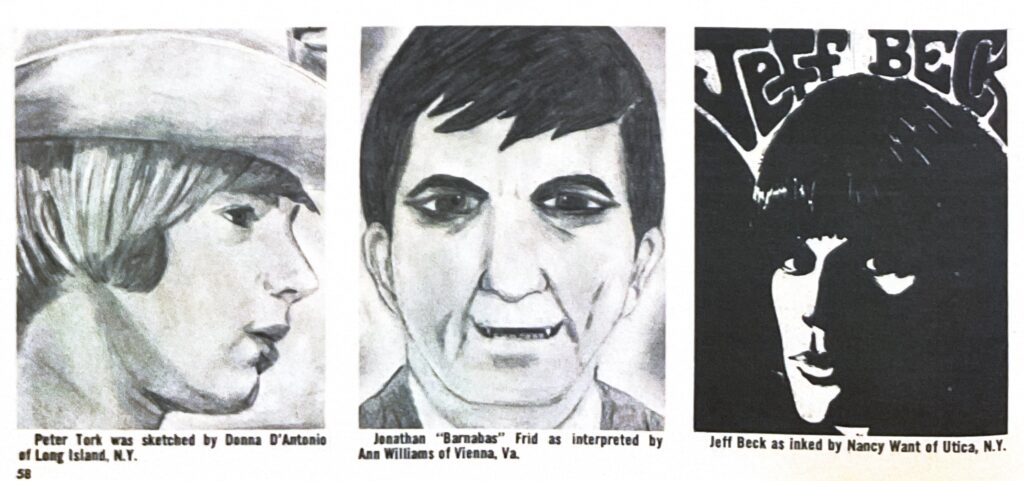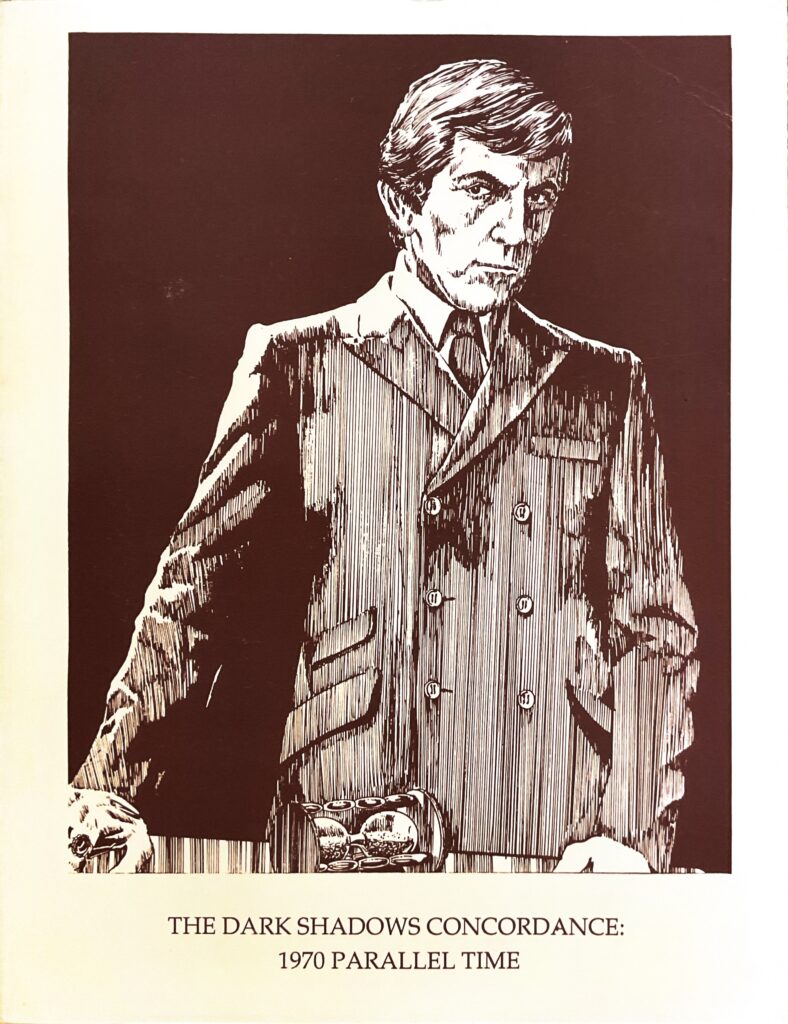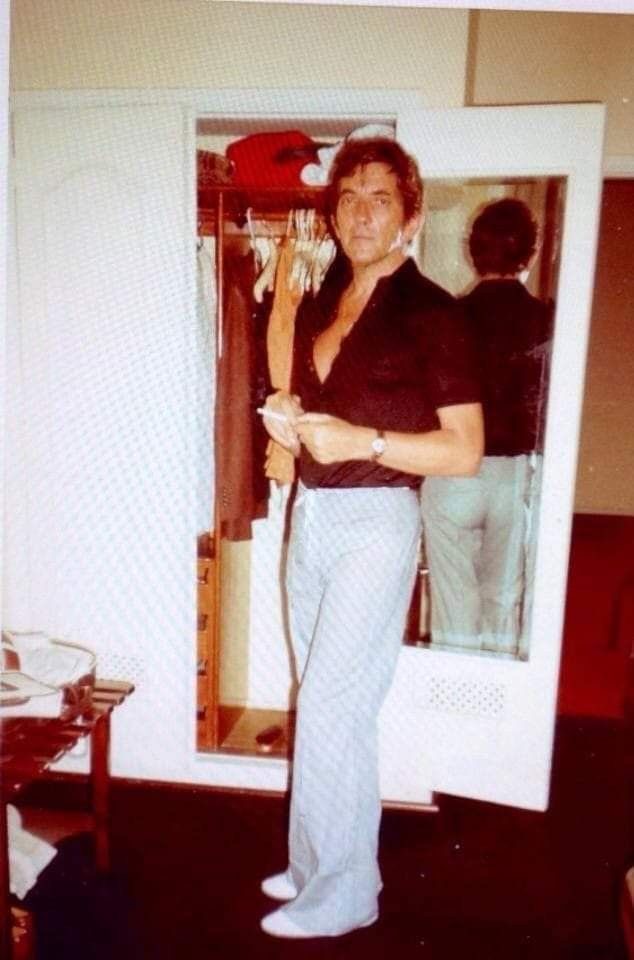
I love to go through old magazines from my youth. After finding an old 16 Magazine, I saw a page where lucky teens had their very own fan art printed for the whole nation to see. The magazine was from the late 1960s, the era of peak Dark Shadows mania, and there were several renderings of Jonathan Frid as Barnabas Collins.


I remembered my venture into fan art during that era. For that reason, I try not to take a shot at someone’s fan art, even when it’s terrible. It’s someone’s best effort and their interpretation. Also, fan art was a way to pass the time in boring situations, like homeroom, or when having a rare creative burst in art class. It’s a win-win for everyone.
Speaking of art class in 1969, I drew a picture of Jonathan Frid laboriously with pastel chalk in the sixth grade. Two other girls sitting near me copied my rendering and then argued over their drawing. It wound up in an altercation, with the two girls pulling on their masterpiece and screaming, “It’s mine! It’s mine! Gimme! Let go! Gimme!” until the paper ripped in two. Our teacher then intervened, separating the two and making them sit on opposite sides of the classroom. As I sat in stunned silence, the teacher yelled at me over my drawing. I hadn’t shaded the nose right and was somehow responsible for starting the ruckus, even though I wasn’t involved. I told my mom about it later. She dismissed my concerns with, “Pfft! Don’t worry. That old bat is going through the change of life, just like your crazy aunt. They are both just alike, and both are married old maids. Just ignore anything that comes out of her flapping mouth!!”
This fit of reminiscing made me review DS fan art from those first days until today. In the 1960s, fan art started as sketches by children. By the 1970s, those children were teenagers and young adults. They were the first to trade fan art among themselves. Then, to share with a broader pool of fans, they put together fanzines featuring drawings and sketches to illustrate fan fiction stories. Though many early fan art pieces were “swipes,” illustrations based on a photo or television scene, all used the traditional method of a human artist putting an image on paper with a physical medium like ink, charcoal, watercolors, etc.
Kathleen Resch’s The World of Dark Shadows showcases the best collection of Dark Shadows fan art. The late Warren Oddsson drew many covers and illustrations. His art, which was simply beautiful and realistic, graced many copies of this zine and various other fan publications. Sadly, I have only one specimen left in my collection.


Fanzines reigned supreme until the mid-1990s. With the advent of the internet and affordable personal computers, the digital age was upon us. As fanzines slowly died out, writing and art moved to Usenet and the Web. The invention of Adobe Photoshop changed the workflow for creating images. Artists could tweak hand-drawn art, produce a final copy quicker, and share it with a wider audience. Photo manipulation became popular. Fans could do something with all those photographs they collected. Promo stills became collages. Retouching old photos became a new pastime. Those fans with more advanced skills rendered familiar photos into digital paintings or combined images to create a new photo. Mock-ups of fantasy books and posters appeared. The ideas were endless.
In the 21st Century, the one-click mobile phone app Artificial Intelligence (AI) generated image is the newest trend. AI is the latest way for fans to create images and manipulate photographs. I’m not going to use any of the AI photos flooding Facebook. I don’t want to embarrass anyone. Look at any fan group page, and you’ll find plenty.
AI remains controversial because it removes human creativity from the equation. AI images also look quite different. Photos manipulated in AI apps tend to look shiny. Highlights become hotspots. Eyes have prominent catchlights and bluish sclera. Sometimes, the eyes aren’t quite aligned correctly, with one eye having a cast and veering off to the wall. Features get smoothed to the point where character lines vanish, and the person looks like a waxwork. AI also has problems with textures, so hair looks solid, or a stubble of beard looks like a dash of black pepper.
Looking at various samples on social media, the actors of Dark Shadows “improved” by AI may look cartoonish, a combination of a photo and a line drawing, or not like themselves at all. Many pictures simply look over-processed and fake. The familiar vestige of Jonathan Frid may take on the appearance of a young Bob Denver as Gilligan. His features smoothed in a reworking of the famous Fire Island photo make him look like an advert for “Young Barnabas in Paradise Cove, a new Hallmark Channel Movie.” Another variation of the same photo gives Frid a prominent nipple that follows the viewer like an eye. One memorable photo I found in my search was of Joan Bennett as Naomi Collins. After an AI improvement, her face became as smooth as a dummy and her gown transformed into poured green vinyl. Well, Orbach’s was mod! A Facebook friend dubbed this image “PlastiJoan” and the AI reworkings “The Eerily Smooth™ Years.”
I’ve not done fan art in decades. Intrigued by AI, I wanted to give it a go. As a control sample, I did a standard, no-frills photograph-to-pencil sketch image in the latest version of Photoshop. A few layers, desaturation, Smart Filters, levels adjustment, and a Gaussian blur later, we have a nice pseudo-sketch of Barnabas by someone who went to town with 4B-6B pencils on high rag paper.

To test the brave new world of AI, I sought out one of the many apps people now use. As most had paywalls, I found one that let you try before parting with money and waiting for a refund when you canceled. The winner was Fotor AI. As a test, I used a challenging photograph of Jon Frid. Digitized in the early years of home scanners, the pic had a terrible moiré pattern. It’s almost impossible to remove using a conventional photo editor. I let Fotor have its way with the photograph, hoping for improvement.

The first attempt helped the moiré pattern in most areas. The whites are so blindingly overexposed the pattern disappears. The moiré on Frid’s trousers is better, but the fabric is now smoothed to the point of being featureless, as are his arms. Moiré is still present on his face as vertical lines, even though his features and hair are blurred. The best improvement is to the table and carry-on bag on the left.

Trying a charcoal filter, Fotor gave me Frid as Keith Prentice. His apartment is now a drawing board with pencils scattered around. Fingers are holding a pencil and the table. Why the table is a drawing implement is anyone’s guess.

I hoped the third time would be a charm, so I tried a line-drawing filter. Frid now morphed into a cartoon Kathryn Leigh Scott. Unfortunately, Frid/Josette has a double exposed arm and more than the standard number of fingers. There’s a George Forman Grill on the table, too. Diet is important.

After giving up on that photograph, I tried something else: I told the AI generator to create a new picture.

The results: I now had a Barnabas Collins Meets Scooby-Doo image. Fingers are missing, and he’s wearing a scarab instead of a ring.
In one last “Hail Mary” attempt, I turned to trusty Photoshop Beta. This Beta version uses Adobe Firefly as an AI text-to-image generator. Like rubbing a magic lamp, I typed in my wish: “Jonathan Frid as Barnabas Collins standing in a cemetery.”

*Poof!* And I got this guy. Close, but no cigar. But, hey, at least he has a positive demeanor!
My AI experiment was not rewarding, but I didn’t invest much time using different programs. Too, I’m not really wild about AI. No matter how large a neural network AI may employ, it will never replace the creative talent of one human brain. At best, the algorithm can ape creativity. I’m sure fans using these apps are having fun. Perhaps “improving” old photographs will lead new people to develop fundamental skills in photo restoration, study graphic arts, or spark an interest in fine art. I hope so. Will AI programs make you an artist? Nope. Like the two sixth graders in time out, it just soullessly copies someone else’s work.

Use Hive’s online AI detection to tell if an image is real, a deepfake, or created by AI.




